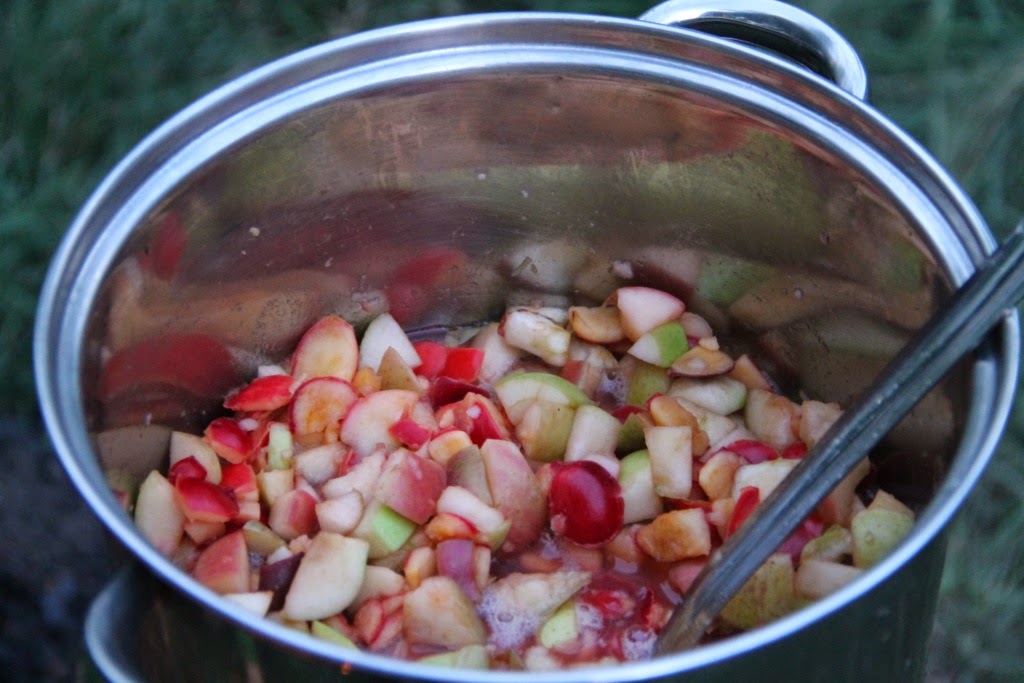Fast forward to August, and weve got piles of apples, crab apples, and plums practically begging to be put into jams, crisps, and the like. And we were only too happy to oblige. The only problem is that Colorado Augusts are typically high-temperature affairs, rendering indoor canning an enjoyable event only for sadistic, nonparticipating observers. Thus, we built some infrastructure to move the operation outdoors, where steam can escape, the kitchen can spread out, and were surrounded by the sweet melodies of avian soloists (including our own rooster, who has been perfecting his crowing technique all day long for several weeks now). And, with the help of our garden kitchen and Dakota rocket silo, were happy to report that these jam sessions were a resounding success!
 |
| Look at all those plums! Tasty little buggers, too. |
 |
| Conjoined plums. These two are kind of like trophy bucks with locked antlers. Fortunately, we were able to come along and rescue them both. |
 |
| One more example of the bounty--plums and a few of the neighbors crab apples. Katie says, "Yay! we finally found a use for those awkward baskets, and they even made the blog!" |
 |
| Heres a panorama of all our essentials for the outdoor jam session: garden kitchen, Dakota rocket silo, wheelbarrow full of wood, pile full of the same wood split into sticks, and lawn chairs in the shade. This kitchen is approximately 500 times larger than our indoor one. Note that the chimney is now four cinder blocks tall instead of the original two. We added on to give a better draft and more comfortable working height. |
 |
| With outdoor jamming, its especially important to make like the French and mise en place. That is, make sure all the jars, lemon juice, pectin, sweetener, jar lids, magic magnetic wand for the jar lids, jar bands, and extra-clean jar wiping rag are in place before you start. Otherwise youll be running gassers back and forth to the house. For more tips, check out this post. She pretty much nails it. |
 |
| Once everything is in place and the fire is roaring, our first step is to simmer the canning jar lids in a pot of water. |
 |
| Then we switch to the fruit. Our order of operations is to clean and pit/core the fruit inside, then bring outside and cook until soft, then bring inside and puree with the stick blender, then bring back out and turn into jam. It sounds like a lot of running, but it wasnt too bad. Better than having a hot, steamy house! We could have saved some running with a long extension cord (so we could do the pureeing outside). Also, dont forget to smear the pot with dish soap so the soot comes off! |
 |
| One thing worth noting is that the fire needs frequent stoking. Either that, or Katie is trying to open a portal to the underworld. Also, dont forget to make cave drawings on your chimney with some of the charcoal you produce. Here we have a caveman on a horse, chasing a chicken. If the longest-lasting outcome of this project is a confused anthropologist 500 years from now, it will still be a success! |
 |
| Later in the day we switched from plums to apples. Even later, we mixed them. We found out that any ratio of plums and apples turns out pretty good. |
 |
| A successful batch of apple-plum jam (or plumple, if you will). The jars will get flipped back over in a few minutes. Make sure to count out the right number of lids! |
Have you done any outdoor canning? What was your setup? What did you can? Let us know in the comments section below!
NOTE: Its now easier to leave comments on the blog--for some reason we had a setting checked that only allowed folks with Google IDs to leave a comment. Why the default setting is so elitist we have no idea, but rest assured it should be fixed now.
A Recipe (using Pomona pectin): Spiced Plumple Jam
4 cups apple and/or plum puree in any ratio. Multiple types of apples gives a more varied apple flavor.
2 teaspoons calcium water
0.25 cups lemon juice
1 teaspoon cinnamon
0.5 teaspoon each allspice, cloves, and nutmeg
2 teaspoons pectin powder
1 cup sugar
Cook cored/pitted apples and/or plums until soft, then puree. Measure out 4 cups of puree and add calcium water, lemon juice, and spices. (Lemon juice and spices are optional--the jam is great without them, too.) Bring to boil, stirring frequently. (Frequent stirring is especially important on the Dakota rocket silo.) Meanwhile, mix the pectin powder and sugar and stir well. When the puree mixture comes to a boil that does not stop when slowly stirred, add sugar-pectin mix and stir vigorously to dissolve. Return to boil and remove from heat. Pour into hot jars, wipe rim with clean damp cloth, and seal. Process by hot water bath according to directions for your elevation. (We usually go with the inversion method because weve had good luck with it and its easier. Food safety experts will tell you its not as reliable as the water bath method. So do what you like, but be warned: your mileage may vary. If you find a jar in the pantry that has come unsealed, dont eat it, even if Katies not around.)